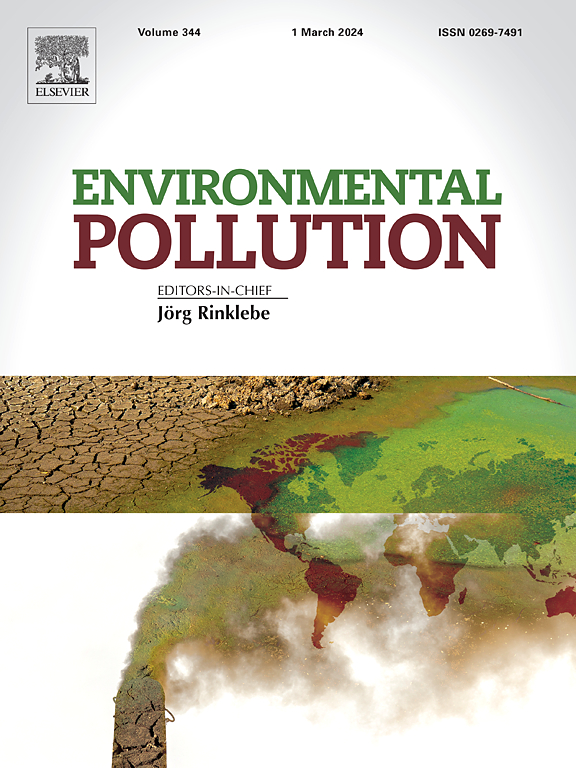Quantitative assessment of microplastics in fish from the Gulf of Guinea, Ghana, using LDIR spectroscopy: Implications for marine food safety and health risk evaluation
IF 7.6
2区 环境科学与生态学
Q1 ENVIRONMENTAL SCIENCES
引用次数: 0
Abstract
In this study, microplastic (MP) contamination was investigated in 24 marine fish species from 3 environmental hotspots- Labadi, Teshie, and Jamestown, along Ghana’s Gulf of Guinea coastline. Specific fish species studied included Pseudotolithus senegalensis, Sphyraena guachancho, Brachydeuterus auratus, Chloroscombrus chrysurus, and Ethmalosa frimbriata. Fifty-eight percent of the total MPs were detected in the gastrointestinal tracts, and 42% detected in gills of 177 individual fish tested in this study. Labadi showed the highest contamination levels [mean MP concentration: 22 ± 19 (items fish)-1]. Omnivorous fish species had the highest mean ingestion rate of MPs (19.4), surpassing both carnivorous (17.7) and herbivorous species (13.5), and indicating dietary habits as a significant factor in MP bioaccumulation. White-coloured MP films (60%) of sizes: 100-1000 µm were the dominant ingested shape. Other MP shapes included fragments (26.3%), fibres (10.5%), beads (1.05%), and foam (0.61%). Using advanced spectroscopic technique such as Laser Direct Infrared (LDIR) Imaging, 16 MP polymers were characterized with polyvinyl chloride (PVC) being the prevalent MP polymer type (80%). The study observed a strong positive correlation between carnivorous demersal and omnivorous pelagic-neritic fish for specific MP polymers, suggesting that factors other than polymer density influence MP consumption patterns for fish habitats within the water column. The annual MP exposure to Ghanaian adults via fish consumption [(194-29,239 MP items (person year)-1] significantly exceeded the European Safety guidelines [518-3078 (items year)-1], emphasizing dietary habits and environmental pollution as key factors. This study provides a critical baseline on MP pollution in Ghanaian marine ecosystems, highlighting the urgent need for interventions to mitigate plastic pollution, protect marine biodiversity, safeguard marine food, and public health in West Africa.

利用LDIR光谱法定量评估加纳几内亚湾鱼类体内的微塑料:对海洋食品安全和健康风险评估的影响。
试剂、化学品和其他材料氢氧化钾球团(KOH)和氯化钠(NaCl,≥99.8%)购自Park Scientific Limited, UK。次氯酸钠稳定溶液(NaClO, 99.6%)来自英国Superchem Products Limited。碘化钠(NaI,纯度99.5%)和乙醇(纯度99.9%)购自英国VWR International Limited。过氧化氢(H2O2≥98%)和氢氧化钠(NaOH, 99.8%)来自德国默克公司。在一升(1L)鱼中制备了30% KOH:NaClO(1:1)溶液。该研究揭示了加纳沿海海鱼中广泛存在的MP污染。从特希、拉巴迪和詹姆斯敦的346条鱼中,共回收了1139条可识别的MPs。在24种鱼类中检测到MPs,其中177条(54.3%)显示摄入MPs的证据。摄入MPs的鱼的数量因地点而异:Teshie记录的最多(n=77),其次是Labadi (n=63)和Jamestown (n=37)。本研究使用LDIR和FTIR对来自加纳几内亚湾的Teshie、Labadi和Jamestown的海鱼的MP污染进行了量化,并估计了食用MP污染鱼类的人类饮食暴露量。MP污染在所有地点和物种中都很普遍,可归因于地点靠近污染源。特定地点的对比显示出与饲养栖息地和污染水平相关的显著差异。最高的平均MP丰度记录在Labadi;未引文献环境部。科技与创新,2020;卫生和水利部,2022。有竞争利益的声明☒作者声明,他们没有已知的可能影响本文所报告工作的有竞争利益的财务利益或个人关系。
本文章由计算机程序翻译,如有差异,请以英文原文为准。
求助全文
约1分钟内获得全文
求助全文
来源期刊

Environmental Pollution
环境科学-环境科学
CiteScore
16.00
自引率
6.70%
发文量
2082
审稿时长
2.9 months
期刊介绍:
Environmental Pollution is an international peer-reviewed journal that publishes high-quality research papers and review articles covering all aspects of environmental pollution and its impacts on ecosystems and human health.
Subject areas include, but are not limited to:
• Sources and occurrences of pollutants that are clearly defined and measured in environmental compartments, food and food-related items, and human bodies;
• Interlinks between contaminant exposure and biological, ecological, and human health effects, including those of climate change;
• Contaminants of emerging concerns (including but not limited to antibiotic resistant microorganisms or genes, microplastics/nanoplastics, electronic wastes, light, and noise) and/or their biological, ecological, or human health effects;
• Laboratory and field studies on the remediation/mitigation of environmental pollution via new techniques and with clear links to biological, ecological, or human health effects;
• Modeling of pollution processes, patterns, or trends that is of clear environmental and/or human health interest;
• New techniques that measure and examine environmental occurrences, transport, behavior, and effects of pollutants within the environment or the laboratory, provided that they can be clearly used to address problems within regional or global environmental compartments.
 求助内容:
求助内容: 应助结果提醒方式:
应助结果提醒方式:


